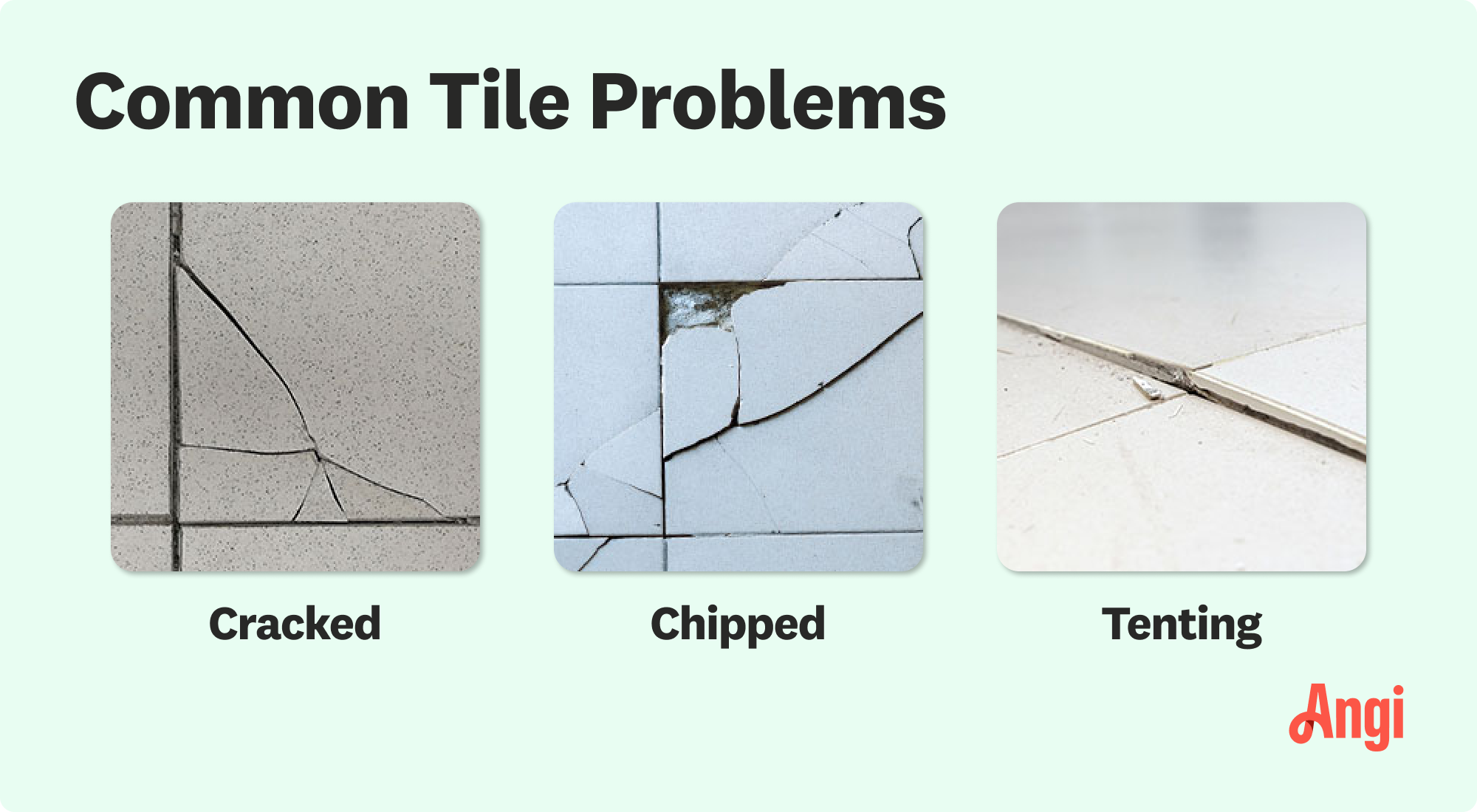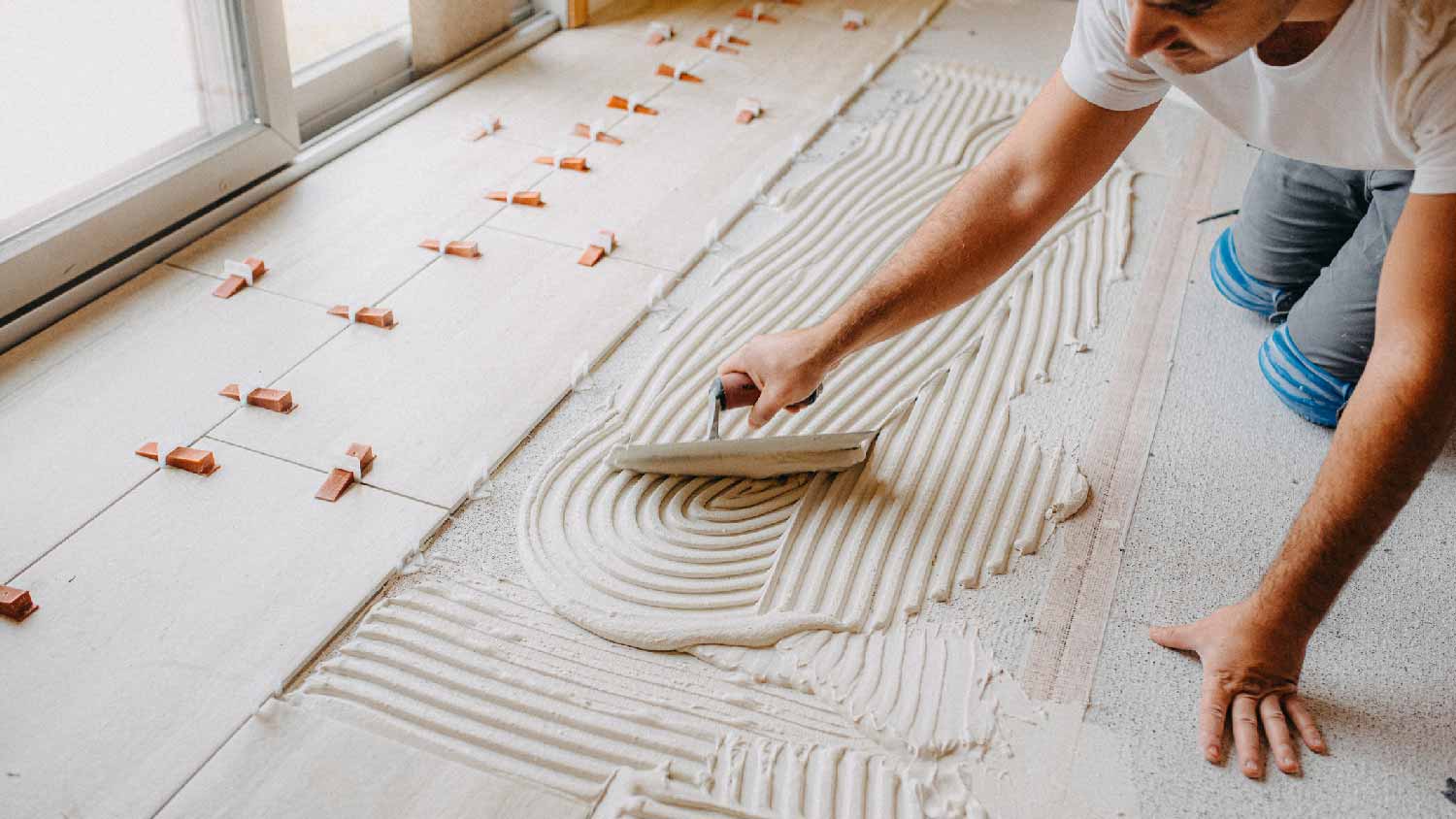How Much Does Tile Repair Cost? [2025 Data]
Tile repair costs $462 on average for a 100-square-foot space, or between $279 and $657, depending on the project's size and scope. A local pro can give you a quote that accounts for the specifics of your ideal results.


Fixing a small chip is easy, but bigger fixes, like regrouting, increase the cost.
Urgent repairs, such as fixing water damage behind tiles, are more expensive.
Ceramic is the least expensive type of tile to repair, while marble often costs the most to fix.
Hiring a tile contractor over a handyperson costs more but will lead to better results.
Repairing tile in moisture-prone areas, like pools or showers, will cost more.
Whether it’s cracked tiles, crumbling grout, or another problem, most tile repair jobs will cost you $462, but prices can range from as little as $135 up to $1,100 or more, including materials and labor. Even if it’s something as minor as a small chip, taking care of these issues right away can help prevent bigger problems in the future. Here’s a breakdown of your overall tile repair cost.
Tile Repair Cost Factors
Here’s a look at the different factors that could affect the tile repair cost.
Size of Area
The cost of your tile repair will depend on many factors, but the size of the area will have the biggest impact. To get a rough estimate, calculate the space's square footage. On average, you can expect to pay $30 per square foot.
Type of Repair
You may need various repairs, from fixing a small chip to a full tile replacement. Many companies charge a minimum fee ranging from $100 to $300.
Here are some common repairs that you may run into:
| Type of Repair | Average Cost |
|---|---|
| Cracked or broken tiles | $130–$500 |
| Chips or holes in tiles | $50–$400 |
| Tile replacement | $120–$500 |
| Water damage | $1,500–$2,000 |
| Shower retiling | $800–$3,000 |
| Grout repair | $100–$700 |
Type of Tile
Consider your tile type to determine the cost of your repair. Depending on your materials, the cost will range between $1 and $40 per square foot or more.
Additionally, labor costs $7 to $30 per square foot. More affordable tile types like ceramic and porcelain are easier to work with, so you can expect labor costs to be on the lower end of the price range compared to something like natural stone.
| Tile Type | Materials Cost per Square Foot |
|---|---|
| Ceramic | $1–$15 |
| Porcelain | $2–$15 |
| Marble | $8–$40 |
| Granite | $5–$14 |
| Slate | $2–$28 |
For more serious issues, you can expect to pay $2 to $45 per square foot for replacement tiles.
Location of Repair
To better understand your repair costs, consider where you need the repairs done. Here are common locations and price ranges you can expect.
| Location | Average Cost |
|---|---|
| Bathroom | $100–$150 |
| Shower | $200–$300 |
| Floor | $50–$700 |
| Pool | $75–$250 |
Labor
Your tile contractor will charge $60 to $100 per hour, while a handyperson charges $50 to $80 per hour. This equals around $7 to $30 per square foot for labor.
It’s best to spend a little more to hire a tile contractor who has the specialized skill set to properly install tile that holds up well to traffic, moisture, and other elements. Look for a tile contractor with at least three years of experience, and check their portfolio or references to find someone who does similar work to your project, such as someone with experience laying penny tile or waterproofing shower tile.
Cost of Tile Repair by Type of Issue

Depending on the issue you're facing, you can get a general idea of the cost of your repair.
| Type of Issue | Average Cost |
|---|---|
| Cracked or broken tile | $130–$500 |
| Chipped tile | $50–$400 |
| Tile tenting | $120–$500 |
| Floor tile replacement | $50–$700 |
| Partial shower retiling | $200–$500 |
| Full shower retiling | $500–$2,600 |
| Tile reglazing | $300–$1,200 |
| Grout repair | $700–$1,750 |
Additional Costs to Consider
Now that you have a good idea of the cost of your tile repair, here are additional costs that may arise. This all depends on your project needs, so check with your contractor.
| Repair Type | Average Cost |
|---|---|
| Water damage repair | $1,500 to $2,000 |
| Tile shower pan replacement | $900 to $3,500 |
| Tile resealing | $0.50 to $2 per square foot |
Cost to Repair Tile Yourself vs. Hiring a Pro

If you’re dealing with small chips or cracks on easy-to-repair tile types, such as ceramic and porcelain, you can tackle the repair if you’re an experienced DIYer. But you’ll need a few tools like a tile cutter, mallet, level, and trowel. If you have natural stone tiles or extensive tile damage, it’s best to bring in a pro with the experience and knowledge to handle the complicated work. Repairing bathroom tile costs an average of $22 per square foot, saving you $7 to $30 per square foot on labor. However, hiring a professional tile repair contractor near you ensures the job is done right and avoids the extra cost and time in the case of a faulty repair.
How to Save on Tile Repairs
Here are some practical ways that you can save on tile repairs.
Fix your tile issues as soon as you notice them to avoid more cracks and chips throughout your tile.
Compare quotes from at least three contractors to find a great price with a trustworthy pro.
Vet your pro before signing a contract. For example, verify their license, read reviews, and ask past clients for referrals.
Save leftover tiles for future repairs.
How Angi Gets Its Cost Data
Home is the most important place on earth, which is why Angi has helped more than 150 million homeowners transform their houses into homes they adore. To help homeowners with their next project, Angi provides readers with the most accurate cost data and upholds strict editorial standards. We’ve surveyed thousands of real Angi customers about their project costs to develop the pricing data you see, so you can make the best decisions for you and your home. We pair this data with research from reputable sources, including the U.S. Bureau of Labor Statistics, academic journals, market studies, and interviews with industry experts—all to ensure our prices reflect real-world projects.
Want to help us improve our cost data? Send us a recent project quote to costquotes@angi.com. Quotes and personal information will not be shared publicly.
Frequently Asked Questions
The extent of the damage will determine whether a broken tile can be fixed without replacing it. For example, epoxy and paint can repair small cracks or chips without replacing the tile. This also assumes that there are no underlying problems, like water damage.
It’s not necessarily normal for tiles to lift, although it’s one of the common issues people may have with their tile flooring. Tiles correctly installed by pros with expansion joints should not lift over time. However, if the installation was done poorly, you might see tiles tenting or lifting as the house settles. This is more common in high-moisture areas with extreme temperatures.
The waterproof membrane between the tiles and the wall backing in your shower area prevents water from seeping into your home's foundational structures and supports. Do not skip adding a waterproof membrane beneath the tiling in your bathroom.
Be sure to check the grout you use before you apply the grout sealer. Sometimes, grout doesn’t actually need sealer at all.
For the rest, apply one thin coat, clean up any excess mess, and let it sit for at least a full day. After a day has passed, go ahead and apply a second thin coat. Again, let that dry for another 24 hours.
That triangular tool you see people using when grouting? It will help you remove excess grout and smooth the surfaces, so it should be on standby. That said, the only tool that really breaks up grout is an oscillating multitool with the grout removal attachment affixed.

.jpg?impolicy=leadImage)













